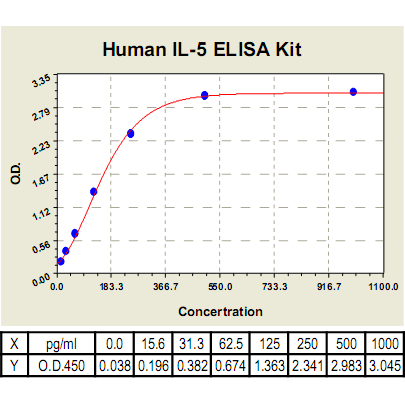IL-5 ELISA Kit, Human |
 |
BACKGROUND IL-5 was originally defined as a T-cell-derived cytokine that triggers activated B cells for terminal differentiation into antibody-secreting plasma cells, at least in mice. Concurrently, IL-5 was recognized as the major maturation and differentiation factor for eosinophils in mice and humans. IL-5 is known to be closely related to the infiltration, activation and proliferation of eosinophils.1 Over-expression of IL-5 significantly increases eosinophil numbers and antibody levels in vivo. Conversely, mice lacking a functional gene for IL-5 or the IL-5 receptor alpha chain (IL-5Rα) display a number of developmental and functional impairments in B-cell and eosinophil lineages. In addition to the Janus kinase–signal transducer and activator of transcription pathway, the tyrosine kinases Lyn and Btk (Bruton agammaglobulinemia tyrosine kinase) are involved, and Ras GTPase–extracellular signal-regulated kinase (Ras–ERK) signals are important for IL-5-dependent cell proliferation and survival.2 IL-5 critically regulates expression of genes involved in proliferation, cell survival and maturation and effector functions of B cells and eosinophils. Thus, IL-5 plays a pivotal role in innate and acquired immune responses and eosinophilia. In humans, the biologic effects of IL-5 are best characterized for eosinophils. The recent expansion in our understanding of the mechanisms of eosinophil development and activation in the context of IL-5 has led to advances in therapeutic options. A new therapy currently in clinical trials uses humanized mAbs against IL-5 or the IL-5R.3
REFERENCES
1. Adachi, T. & Alam,R.: Am J Physiol Cell Physiol 275:C623-C633, 1998
2. Lee, W-H. et al: J. Cell. Biochem. 106:929-36, 20093. Walsh, G.M.: Curr Opin Mol Ther. 11:329-36, 2009
Products are for research use only. They are not intended for human, animal, or diagnostic applications.
Параметры
Cat.No.: | CL0407 |
Target Protein Species: | Human |
Range: | 15.6pg/ml-1000pg/ml |
Specificity: | No detectable cross-reactivity with any other cytokine. |
Storage: | Store at 4°C. Use within 6 months. |
ELISA Kits are based on standard sandwich enzyme-linked immunosorbent assay technology. Freshly prepared standards, samples, and solutions are recommended for best results.
Документы
Информация представлена исключительно в ознакомительных целях и ни при каких условиях не является публичной офертой








